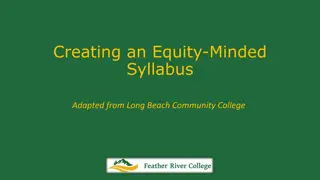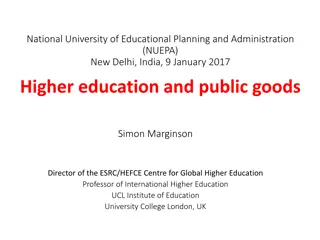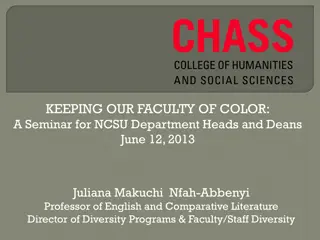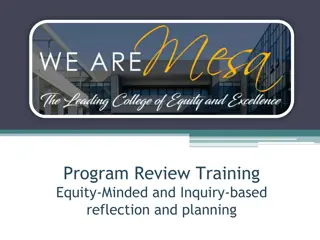Advancing the Equity Agenda: Equity-Minded Goalsetting in Higher Education
Engage in the Equity Agenda by setting clear goals for racial equity and dismantling systemic barriers faced by students of color. Learn about Lumina Foundation grants, the TIE Grant Project, Equity Institutions Grant Project, and the Data Dashboard Challenge Grant Project aimed at monitoring progress and informing policy decisions. Explore external factors that may impact progress towards equity-minded goals.
Download Presentation

Please find below an Image/Link to download the presentation.
The content on the website is provided AS IS for your information and personal use only. It may not be sold, licensed, or shared on other websites without obtaining consent from the author.If you encounter any issues during the download, it is possible that the publisher has removed the file from their server.
You are allowed to download the files provided on this website for personal or commercial use, subject to the condition that they are used lawfully. All files are the property of their respective owners.
The content on the website is provided AS IS for your information and personal use only. It may not be sold, licensed, or shared on other websites without obtaining consent from the author.
E N D
Presentation Transcript
Advancing the Equity Agenda Equity-Minded Goalsetting Board of Higher Education Meeting May 5, 2020
Equity-Minded Goalsetting Context DHE has been solicited to apply for multiple Lumina Foundation grants, totaling to $1.25m, to support the Equity Agenda APPLICATION PLANNED APPLICATIONS SUBMITTED TIE (Talent, Innovation, Equity) Grant Project intended to support systemwide work focused on racial equity and dismantling systemic barriers faced by students of color Requires setting of clear goals for equity and attainment Equity Institutions Grant Project intended to complement systemwide TIE work by elevating and linking the work of six Equity Institutions: CC: Bunker Hill, Greenfield, Holyoke SU: Bridgewater, MassArt UMass Boston Data Dashboard Challenge Grant Project intended to support monitoring and reassessing progress toward TIE Grant goals at state and regional/local levels, and building forecast scenarios to better inform ongoing goalsetting, policy & budgetary decisions, policy implementations 2
Equity-Minded Goalsetting Context DHE has been solicited to apply for multiple Lumina Foundation grants, totaling to $1.25m, to support the Equity Agenda APPLICATION PLANNED APPLICATIONS SUBMITTED TIE (Talent, Innovation, Equity) Grant Project intended to support systemwide work focused on racial equity and dismantling systemic barriers faced by students of color Requires setting of clear goals for equity and attainment Equity Institutions Grant Project intended to complement systemwide TIE work by elevating and linking the work of six Equity Institutions: CC: Bunker Hill, Greenfield, Holyoke SU: Bridgewater, MassArt UMass Boston Data Dashboard Challenge Grant Project intended to support monitoring and reassessing progress toward TIE Grant goals at state and regional/local levels, and building forecast scenarios to better inform ongoing goalsetting, policy & budgetary decisions, policy implementations 3
External Factors that May Affect Progress Toward Equity-Minded Goals Equity-Minded Goalsetting
External Factors that May Affect Progress Toward Goals Key Potential Factors Demographic Changes Impact of K 12 Trends Demand for Higher Education Funding for Higher Education College Closures & Mergers Economy 5
External Factors that May Affect Progress Toward Goals Key Potential Factors fewer students in traditional-age pipeline growth in populations that have traditionally been underserved by higher education retirements of working-age residents with postsecondary credentials regional variation in population and demographic trends, especially in urban vs. rural regions Demographic Changes Impact of K 12 Trends Demand for Higher Education Funding for Higher Education College Closures & Mergers Economy 6
External Factors that May Affect Progress Toward Goals Key Potential Factors continued declines in high school dropout rates interest in vocational education leading to direct employment after HS Demographic Changes Impact of K 12 Trends Demand for Higher Education Funding for Higher Education College Closures & Mergers Economy 7
External Factors that May Affect Progress Toward Goals Key Potential Factors Demographic Changes Impact of K 12 Trends Demand for Higher Education Funding for Higher Education College Closures & Mergers Economy shifting attitudes toward value of higher education changes in employer requirements for postsecondary credentials/types 8
External Factors that May Affect Progress Toward Goals Key Potential Factors Demographic Changes Impact of K 12 Trends Demand for Higher Education Funding for Higher Education College Closures & Mergers Economy changes in federal & state funding for financial aid & higher education 9
External Factors that May Affect Progress Toward Goals Key Potential Factors Demographic Changes Impact of K 12 Trends Demand for Higher Education Funding for Higher Education College Closures & Mergers Economy student progress toward completion may be disrupted by closures public institutions may attract students from closed institutions 10
External Factors that May Affect Progress Toward Goals Key Potential Factors Demographic Changes Impact of K 12 Trends Demand for Higher Education Funding for Higher Education College Closures & Mergers Economy changes in in-migration of educated workers, e.g., driven by employment opportunities changes in out-migration of educated workers, e.g., driven by cost of living higher unemployment rates are correlated with enrollment increases, especially at community colleges (but not necessarily increases in completion rates) 11
External Factors that May Affect Progress Toward Goals Key Potential Factors May produce unprecedented shifts in many aforementioned factors higher unemployment rates decreases in federal and state funding college closures and mergers May introduce new factors emotional trauma and health concerns affecting student progress, whether they are retained or not students questioning cost/value of remote learning vs. traditional inequitable access to or design of remote learning impact on international students & enrollment Demographic Changes Impact of K 12 Trends Demand for Higher Education Funding for Higher Education College Closures & Mergers Economy 12
External Factors that May Affect Progress Toward Goals Impact on Goalsetting Baselines and forecasts for today s goalsetting are largely based on historical trends New, evolving reality and analytic advancements may require revisiting these goals in the future COVID-19 especially may negatively affect projections and goals, but should also serve as a strong imperative and perhaps an opportunity to address inequities in higher education 13
State Population Goals Equity-Minded Goalsetting
State Population Goals 1. High-Quality Certificate & Higher % of Massachusetts residents ages 25 64 who hold a high-quality certificate or higher METRIC Trend & baseline source: Lumina Foundation, Stronger Nation annual reports; most recently published in February 2020 Lumina data sources: Associate degree & higher: U.S. Census Bureau High-quality certificate: Lumina/Georgetown Center for Education and Workforce analysis of U.S. Census Bureau and IPEDS data Note: High-quality means earnings of graduates are 20% higher than earnings of adults with only a HS diploma TIE Grant Requirement: Set a goal on this metric to achieve by 2030 15
State Population Goals 1. High-Quality Certificate & Higher % of Massachusetts residents ages 25 64 who hold a high-quality certificate or higher 16
State Population Goals 1. High-Quality Certificate & Higher % of Massachusetts residents ages 25 64 who hold a high-quality certificate or higher Only five years of trend data are available, as high-quality certificates were not tracked by Lumina prior to 2014. 17
State Population Goals 1. High-Quality Certificate & Higher % of Massachusetts residents ages 25 64 who hold a high-quality certificate or higher As mentioned, BHE reserves the right to increase this goal if future modeling suggest more robust increases are likely. 18
State Population Goals 2. Equity in Associate Degree & Higher % of Mass. residents ages 25 64 who hold an associate degree or higher by race/ethnicity METRIC Trend & baseline source: Lumina Foundation, Stronger Nation annual reports; most recently published in February 2020 Lumina data sources: Associate degree & higher: U.S. Census Bureau Note: High-quality certificate data is excluded because it does not allow for disaggregation by race/ethnicity Forecast source: Mass. Department of Higher Education TIE Grant Requirement: Set a goal to increase these rates for African American & Latinx residents by 5 percentage points by 2024 (the end of the grant period) 19
State Population Goals 2. Equity in Associate Degree & Higher % of Mass. residents ages 25 64 who hold an associate degree or higher Latinx 20
State Population Goals 2. Equity in Associate Degree & Higher % of Mass. residents ages 25 64 who hold an associate degree or higher Latinx Goal meets Lumina requirement to increase rate by 5 percentage points by 2024. 21
State Population Goals 2. Equity in Associate Degree & Higher % of Mass. residents ages 25 64 who hold an associate degree or higher Latinx Upward trend has been rather steady for 10 years; forecast shown with 95% prediction interval. 22
State Population Goals 2. Equity in Associate Degree & Higher % of Mass. residents ages 25 64 who hold an associate degree or higher Latinx Lumina s prescribed goal falls within the 95% prediction interval. 23
State Population Goals 2. Equity in Associate Degree & Higher % of Mass. residents ages 25 64 who hold an associate degree or higher African American 24
State Population Goals 2. Equity in Associate Degree & Higher % of Mass. residents ages 25 64 who hold an associate degree or higher African American Goal meets Lumina requirement to increase rate by 5 percentage points by 2024. 25
State Population Goals 2. Equity in Associate Degree & Higher % of Mass. residents ages 25 64 who hold an associate degree or higher African American Volatile trend means the prediction interval is wide, even in the near-term years. 26
State Population Goals 2. Equity in Associate Degree & Higher % of Mass. residents ages 25 64 who hold an associate degree or higher African American Lumina s prescribed goal will require outpacing this forecast. 27
State Population Goals 2. Equity in Associate Degree & Higher Context: Past trend shows large, persistent disparities over time, despite increased rates for each subgroup 28
State Population Goals 2. Equity in Associate Degree & Higher Context: Achieving goal may mean progress in reducing disparities, along with increased rates for each subgroup 29
Massachusetts Public Higher Education Goals Equity-Minded Goalsetting
Massachusetts Public Higher Education Goals 3. Equity in Public Higher Ed Completion Significance of Public Higher Ed Completion Metric Area in which BHE policy decisions have the most direct impact Majority of students of color in postsecondary education in Massachusetts attend public institutions % of Massachusetts postsecondary students enrolled in public higher ed (FY2018): 62% of African American undergraduates 61% of Latinx undergraduates 54% of White undergraduates Source: U.S. Department of Education (IPEDS) 31
Massachusetts Public Higher Education Goals 3. Equity in Public Higher Ed Completion % of students completing credential after first enrolling in Mass. public higher education by race/ethnicity METRIC Trend & baseline source: Mass. Department of Higher Education (HEIRS), National Student Clearinghouse Cohort: All students who enter Mass. public higher education as first-time undergraduates or new transfer students, whether full- or part-time Desired Outcome: Students graduate with a certificate or degree within six years from any institution in U.S., public or private Note: Agnostic of which segment/institution the student initially attended one metric for whole system Forecast source: Mass. Department of Higher Education TIE Grant Requirement: Set an aspirational goal to achieve by 2024 32
Massachusetts Public Higher Education Goals 3. Equity in Public Higher Ed Completion % of students completing credential after first enrolling in Mass. public higher education Latinx (Entered 2013, earned credential by 2019) 33
Massachusetts Public Higher Education Goals 3. Equity in Public Higher Ed Completion % of students completing credential after first enrolling in Mass. public higher education Latinx (Entered 2005, earned credential by 2011) (Entered 2013, earned credential by 2019) (Entered 2018, earn credential by 2024) (Enter 2024, earn credential by 2030) Trend is volatile, with a dip in the rate for the cohorts who enrolled during the Great Recession. AAGR for 2011 2019 (1.8%) applied to future cohorts. 34
Massachusetts Public Higher Education Goals 3. Equity in Public Higher Ed Completion % of students completing credential after first enrolling in Mass. public higher education Latinx (Entered 2005, earned credential by 2011) (Entered 2013, earned credential by 2019) (Entered 2018, earn credential by 2024) (Enter 2024, earn credential by 2030) Goal represents aspiration to exceed current pace by 5% in 2024 (40 * 1.05 = 42) and 10% in 2030 (45 * 1.1 = 50). 35
Massachusetts Public Higher Education Goals 3. Equity in Public Higher Ed Completion % of students completing credential after first enrolling in Mass. public higher education African American (Entered 2013, earned credential by 2019) 36
Massachusetts Public Higher Education Goals 3. Equity in Public Higher Ed Completion % of students completing credential after first enrolling in Mass. public higher education African American (Entered 2005, earned credential by 2011) (Entered 2013, earned credential by 2019) (Entered 2018, earn credential by 2024) (Enter 2024, earn credential by 2030) Trend is volatile, but mostly climbing, even during Great Recession. AAGR for 2011 2019 (1.4%) applied to future cohorts. 37
Massachusetts Public Higher Education Goals 3. Equity in Public Higher Ed Completion % of students completing credential after first enrolling in Mass. public higher education African American (Entered 2005, earned credential by 2011) (Entered 2013, earned credential by 2019) (Entered 2018, earn credential by 2024) (Enter 2024, earn credential by 2030) Goal represents aspiration to exceed current pace by 5% in 2024 (42 * 1.05 = 44) and 10% in 2030 (46 * 1.1 = 51) 38
Massachusetts Public Higher Education Goals 3. Equity in Public Higher Ed Completion Context: Forecast shows disparities widening slightly over time, despite increased rates for each subgroup 39
Massachusetts Public Higher Education Goals 3. Equity in Public Higher Ed Completion Context: Achieving 2030 goal would mean a nearly 25% reduction in disparities, along with increased rates for each subgroup 40
Massachusetts Public Higher Education Goals 4. Equity in First-Year Success Short-Term Reporting While pursuing these long-term goals, DHE will also track and report on racial/ethnic gaps in first-year success metrics incorporated into PMRS, including: Completion of college-level math and English in the first year On-time credit accumulation Persistence to a second year of postsecondary education Source: Massachusetts Department of Higher Education (HEIRS) 41
Planning to Develop Equity Agenda Goal Dashboard Equity-Minded Goalsetting
Planning to Develop Equity Agenda Goal Dashboard Data Dashboard Challenge Grant DHE was solicited to apply for a Data Dashboard Challenge Grant, created to help states develop dashboards that: Improve utilization of state data systems for policy-making and decision-making May serve as exemplars to other states 43
Planning to Develop Equity Agenda Goal Dashboard Dashboard Vision Support the needs of stakeholders to ensure student success by: monitoring and reassessing progress toward DHE s Equity Agenda goals at the state level, as well as regional or local level, through 2030 understanding how the goals interrelate testing and demonstrating the potential effect of different policy & budgetary levers on outcomes 44
Planning to Develop Equity Agenda Goal Dashboard Phase One: Planning & Buy-in To mobilize higher education and advance state policy to support the Equity Agenda, dashboard must be: built through system-wide collaboration highly relevant to decision-makers who ultimately influence alignment of resources with goals 45
Planning to Develop Equity Agenda Goal Dashboard Phase One: Planning & Buy-in In planning and throughout project, DHE will consult with: Partners in state government (BHE, EOE, BESE/DESE, EOLWD) Leadership of public campuses Institutional research colleagues from public campuses Representatives of other intended audiences (campus trustees, Governor s Office, Legislature, think tanks, business leadership groups, philanthropic organizations, etc.) Researchers & academics from outside the public higher education system 46
Planning to Develop Equity Agenda Goal Dashboard Phase Two: Analysis The project will require extensive methodological work, including: a method to knit the Equity Agenda goals together so that projected progress on Goal 3 can be seen in Goals 1 & 2 projectionsof baselinepublic higher ed enrollment for next 5 10 cohorts methodologiesto demonstrate and model the impact of policy & budgetary decisions on Goal 3, and consequently Goals 1 & 2 47
Planning to Develop Equity Agenda Goal Dashboard Phase Two: Analysis Policy and budgetary levers that we ll explore with research & data science experts include changes in: First-year momentum (Goal 4) Rate of completion of Gateway Math & English courses during first year (or first 24 credits) On-time credit accumulation rates during first year (or first 24 credits) Rate of retention from first year to second year Enrollment or representation rates Participation in Early College and other innovative pathways Affordability (net price, unmet need, etc.) Participation in wraparound student supports 48
Planning to Develop Equity Agenda Goal Dashboard Phase Two: Analysis Depending on the lever, analysis may call for an academic research approach or a data science approach; for example: To model impact of participation in Early College, we can examine existing academic research, seeking studies of comparable programs/states and drawing insights from their findings To model impact of meeting On-time Credit Accumulation targets vs. not, we can likely draw insights from our own campuses historical data 49
Planning to Develop Equity Agenda Goal Dashboard Phase Three: Design DHE will then design a public-facing dashboard that fulfills the vision with: technical support to incorporate complex features such as dynamic forecasting with interrelated parameters continued engagement of stakeholders to vet prototypes and ensure continued buy-in 50























